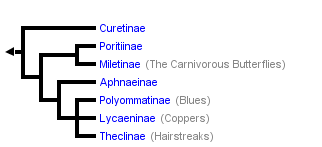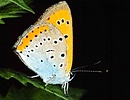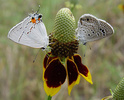Lycaenidae
Gossamer-winged butterflies
Andrew V. Z. Brower


This tree diagram shows the relationships between several groups of organisms.
The root of the current tree connects the organisms featured in this tree to their containing group and the rest of the Tree of Life. The basal branching point in the tree represents the ancestor of the other groups in the tree. This ancestor diversified over time into several descendent subgroups, which are represented as internal nodes and terminal taxa to the right.

You can click on the root to travel down the Tree of Life all the way to the root of all Life, and you can click on the names of descendent subgroups to travel up the Tree of Life all the way to individual species.
For more information on ToL tree formatting, please see Interpreting the Tree or Classification. To learn more about phylogenetic trees, please visit our Phylogenetic Biology pages.
close boxIntroduction
The Lycaenidae as construed here includes the blues, coppers and hairstreaks, but not the metalmarks, which are viewed as a sister-family Riodinidae, based on the combined phylogenetic analysis of morphological and molecular data by Wahlberg et al. (2005). The vast majority of lycaenids are in the clade that includes the blues (Polyommatinae), coppers (Lycaeninae) and hairstreaks (Theclinae). Eliot (who viewed these taxa as tribes of a more inclusive Lycaeninae in Corbet et al. 1992) implied that Aphnaeinae is the sister group to the other three subfamilies based on characters of the larval head capsule.
Discussion of Phylogenetic Relationships
The higher classification of Lycaenidae is currently in flux. The subfamilies, tribes and subtribes enumerated within this clade are for the most part the groups listed by Eliot (1973, 1992 [in Corbet et al.]). Note that the higher classifications presented by Eliot in 1973 and 1992 differ from one another in that the 1992 version reduced the three diverse subfamilies Lycaeninae, Polyommatinae and Theclinae to tribes within an inclusive "Lycaeninae," in order to reflect their affinity to one another with respect to Curetinae, Poritiinae and Miletinae. That change has not been generally adopted by the lycaenid research community (R. K. Robbins, pers. comm, 4/08), and has not been incorporated here. Note also that Eliot's classification was intuitive, and the monophyly and implied relationships among these groups should therefore be viewed as tentative, pending revelations from the large amount of molecular evidence that is currently being gathered by Naomi Pierce and colleagues. The relationships shown among the four subfamilies are those inferred by Wahlberg et al. (2005).
References
Ackery, P. R., R. de Jong, and R. I. Vane-Wright. 1999. The butterflies: Hedyloidea, Hesperioidea, and Papilionoidea. Pages 264-300 in: Lepidoptera: Moths and Butterflies. 1. Evolution, Systematics, and Biogeography. Handbook of Zoology Vol. IV, Part 35. N. P. Kristensen, ed. De Gruyter, Berlin and New York.
Corbet A. S., Pendlebury H. M., and Eliot J. N. 1992. The butterflies of the Malay Peninsula. Malayan Nature Society, Kuala Lumpur.
Eliot J. N. 1973. The higher classification of the Lycaenidae (Lepidoptera): a tentative arrangement. Bull. Br. Mus. Nat. Hist. (Ent.) 28: 371-505, 6 pls.
Wahlberg N, Braby MF, Brower AVZ, de Jong R, Lee M-M, Nylin S, Pierce NE, Sperling FAH, Vila R, Warren AD, and Zakharov E. 2005. Synergistic effects of combining morphological and molecular data in resolving the phylogeny of butterflies and skippers. Proc. R. Soc. Lond. B 272: 1577-1586.
Title Illustrations

| Scientific Name | Lycaena dispar |
|---|---|
| Location | “Bosco della Panfilia” Park, Ferrara Province, Emilia Romagna, Italy |
| Specimen Condition | Live Specimen |
| Image Use |
 This media file is licensed under the Creative Commons Attribution-NonCommercial License - Version 2.0. This media file is licensed under the Creative Commons Attribution-NonCommercial License - Version 2.0.
|
| Copyright |
© 2005 Cesare Brizio

|
| Scientific Name | Strymon melinus and Echinargus isola |
|---|---|
| Specimen Condition | Live Specimen |
| Copyright |
© Melody Lytle

|
| Scientific Name | Feniseca tarquinius |
|---|---|
| Location | Durham County, North Carolina USA |
| Comments | Captured, posed. |
| Specimen Condition | Live Specimen |
| Identified By | Patrick Coin |
| Life Cycle Stage | adult (imago) |
| View | lateral |
| Image Use |
 This media file is licensed under the Creative Commons Attribution-NonCommercial License - Version 2.5. This media file is licensed under the Creative Commons Attribution-NonCommercial License - Version 2.5.
|
| Copyright |
© 2006 Patrick Coin

|
About This Page

Middle Tennessee State University, Murfreesboro, Tennessee, USA
Correspondence regarding this page should be directed to Andrew V. Z. Brower at
Page copyright © 2007
 Page: Tree of Life
Lycaenidae . Gossamer-winged butterflies.
Authored by
Andrew V. Z. Brower.
The TEXT of this page is licensed under the
Creative Commons Attribution License - Version 3.0. Note that images and other media
featured on this page are each governed by their own license, and they may or may not be available
for reuse. Click on an image or a media link to access the media data window, which provides the
relevant licensing information. For the general terms and conditions of ToL material reuse and
redistribution, please see the Tree of Life Copyright
Policies.
Page: Tree of Life
Lycaenidae . Gossamer-winged butterflies.
Authored by
Andrew V. Z. Brower.
The TEXT of this page is licensed under the
Creative Commons Attribution License - Version 3.0. Note that images and other media
featured on this page are each governed by their own license, and they may or may not be available
for reuse. Click on an image or a media link to access the media data window, which provides the
relevant licensing information. For the general terms and conditions of ToL material reuse and
redistribution, please see the Tree of Life Copyright
Policies.
- Content changed 25 April 2008
Citing this page:
Brower, Andrew V. Z. 2008. Lycaenidae . Gossamer-winged butterflies. Version 25 April 2008 (under construction). http://tolweb.org/Lycaenidae/12175/2008.04.25 in The Tree of Life Web Project, http://tolweb.org/











 Go to quick links
Go to quick search
Go to navigation for this section of the ToL site
Go to detailed links for the ToL site
Go to quick links
Go to quick search
Go to navigation for this section of the ToL site
Go to detailed links for the ToL site